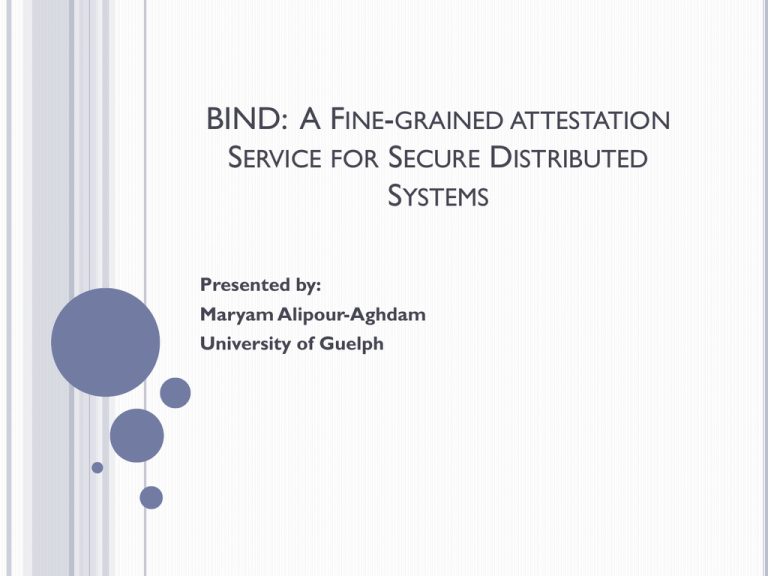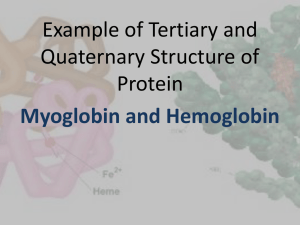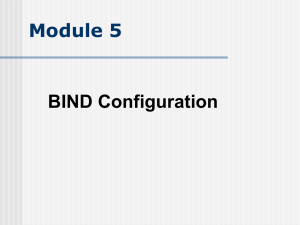BIND: A Fine- - University of Guelph
advertisement

BIND: A FINE-GRAINED ATTESTATION SERVICE FOR SECURE DISTRIBUTED SYSTEMS Presented by: Maryam Alipour-Aghdam University of Guelph OVERVIEW Motivation BIND Overview BIND Interface BIND Properties Application of BIND 2 OVERVIEW Motivation BIND Overview BIND Interface BIND Properties Application of BIND 3 MOTIVATION To securing distributed systems To address issues such as: difficulty in verification of hash due to variability in software verification and configuration to address the time of use and the time of discrepancy the code may be correct at the attestation time and compromised at the use time. 4 OVERVIEW Motivation BIND Overview BIND Interface BIND Properties Application of BIND 5 BIND OVERVIEW Security issue Byzantine attack: A remote software platform may be compromised and run malicious code. The purpose of using code attestation identify what software is running on a remote platform detect a corrupted participant 6 BIND OVERVIEW BIND Proposed Properties perform fine-grained attestation BIND attests only the piece of code instead of entire memory content narrows the gap between time-of-attestation and time-of-use measures a piece of code immediately before it executed use a sand boxing mechanism to protect the execution of attested code ties the code attestation with the data that the code produces 7 BIND OVERVIEW Distributed system model: Process Data Intermediary 8 BIND OVERVIEW Distributed system model: Process a producer or consumer of data represent program logic a piece of software code which needs to be attested * Data information exchange between the processes Primitive data : external input to distributed systems Derived data : output of some process generated by applying protocol logic over some input data 9 BIND OVERVIEW Distributed system model: Intermediary medium over which data is communicated from/to a process network that forward the data between hosts operating system that dispatches the data to the process hard drive or any part of RAM outside the process 10 BIND OVERVIEW 2.2.2.2 1.1.1.1 3.3.3.3 Dest= 3.3.3.3, TTL=9 Dest= 3.3.3.3, TTL=10 Ping 3.3.3.3 -t 10 PB PA Pong Local Configuration Local Configuration Local Configuration Pong PC Pong Figure 1. Simple Ping: The conceptual model for distributed protocols 11 BIND OVERVIEW Figure 1. Simple Ping: The conceptual model for distributed protocols 12 BIND OVERVIEW Figure 1. Simple Ping: The conceptual model for distributed protocols 13 BIND OVERVIEW Figure 1. Simple Ping: The conceptual model for distributed protocols 14 BIND OVERVIEW Figure 1. Simple Ping: The conceptual model for distributed protocols 15 BIND OVERVIEW Figure 1. Simple Ping: The conceptual model for distributed protocols 16 BIND OVERVIEW Figure 1. Simple Ping: The conceptual model for distributed protocols 17 BIND OVERVIEW Ping-Pong Protocol: Process PA, PB, and PC which runs on host A, B, and C Data User command (primitive data) Ping pong messages (derived data) Local IP address of each host (primitive data) Intermediaries network and operating system 18 BIND OVERVIEW Security problems in distributed systems Byzantine attacker model: Malicious intermediary and the data misuse attack Malicious process and the data falsification attack 19 BIND OVERVIEW Security problems in distributed systems Byzantine attacker model: Malicious intermediary and the data misuse attack Threats: alter and inject protocol data data misuse attack which use authenticated protocol data in a malicious way Solution: employ cryptography constructions Example: message authentication code, digital signature 20 BIND OVERVIEW Security problems in distributed systems Byzantine attacker model: Malicious process and the data falsification attack Threats: Injecting bogus data into the distributed systems (data falsification attack) Traditional cryptography can not be used As malicious process has the correct cryptography keys to disguise itself as a legitimate participant Example: a malicious process can modify the TTL field in a ping message. 21 BIND OVERVIEW Attestation Design Consideration Coarse-grained attestation Attestation over entire software platforms Fine-grained attestation attestation over a critical piece of code create distinction between process and intermediary to enable the notion of granularity in attestation to create boundary between what code is being attested to and what is not both process and intermediary exist in the form of software code in reality 22 BIND OVERVIEW Attestation Design Consideration Fine-grained attestation properties simplifies hash verification perform software upgrade more easily as expected hash for each process can be updated independently allow distributed system architect to focus on the security of critical module by singling it out form a complicated system does not address intermediary attacks 23 BIND OVERVIEW Desired Properties of BIND Attestation Service should be free of all software attacks process is correct at load-time needs to be efficient 24 BIND OVERVIEW Process and Data Integrity Defining Process and Data Integrity process is a piece of code (process) when the data is primitive and is genuine (data integrity) the data is derived by running a genuine process over genuine data inputs (data integrity) 25 BIND OVERVIEW Techniques to ensure the integrity of primitive data Semantic Check Example: A distributed scientific computing application checks if an input matrix is well-formed. Certificates use a central trusted authority to sign certificate for primitive data Trusted Path use trusted path mechanisms for input data to make sure the data came from an authenticated user 26 BIND OVERVIEW Techniques to ensure the integrity of process and derived data Authenticator is produced by BIND Generates a process for every piece of data Is attached to data through its life-time Example: when the data is sent over the network, or stored and fetched from local untrusted storage 27 OVERVIEW Motivation BIND Overview BIND Interface BIND Properties Application of BIND 28 BIND INTERFACE 1. Initiate an attestation phase 2. Memory addresses of the process input data 3. Size of process code 4. receiving the ATTESTATION-INIT request 5.Verifies authenticator on input data 6. Hashes the process code along with input data 29 7. If above step successful, yields control to the processor with a success indicator BIND INTERFACE 1. In response to ATTESTATION-COMPLETE command 2. BIND computes an authentication tag over 3. an output data 4. a hash of the process code 5. Authentication tag binds the output data with the code that has generated it. 6. BINDs undoes the protection it has set up for the protection. 7. BINDs returns the authenticator to the process. 30 OVERVIEW Motivation BIND Overview BIND Interface BIND Properties Application of BIND 31 BIND PROPERTIES Fine-grained Attestation: ATTESTATION-INIT indicate the beginning of process ATTESTATION-COMPLETE indicates the end of process Binding Process and Data Integrity derived data builds on the integrity of its generating process integrity of a processes and data are inseparable from each other in DC 32 BIND PROPERTIES Transitive Integrity Verification BINDs achieves this property with O(1) overhead. Efficient TPM’s hardware-based cryptography engine is utilized to enable fast cryptography computations needed for attestation. 33 BIND PROPERTIES Trusted Platform Module (TPM) 34 BIND PROPERTIES TPM in Attestation Overview The signature on the input data is validated through public signing key of TPM that signed the input data Secure Kernel (SK) sends the output data to be signed by TPM. SK utilizes the TPM’ s hashing and digital signature functionalities. 35 BIND PROPERTIES A Symmetric Key Alternative Asymmetric key cryptography has high computational overhead A secret MAC key should be established between two TPMs. TPM’ s SHA-1 function instantiate a MAC between TPMs. The key should be sealed in TPM’s memory and should be remained invisible to untrusted party Example: application code, peripheral devices 36 BIND PROPERTIES A Symmetric Key Alternative The key are unsealed to the SK upon time of use which used by SK to verify the MAC on input data compute the MAC over output data and the hash of process code secret key remain in SK’s memory for a controlled period of time after usage the secret key should be destroyed SK should be executed in a globally uninterrupted manner to prevent untrusted OS Kernel form reading off the secret key information 37 BIND PROPERTIES A Symmetric Key Alternative Diffie-Hellman for key exchange in BIND K−1 (A) is private signing key for TPMA The signing pair (K-1 (A), KA) is created inside TPM SHA-1 functionality presents MAC function using the TPM 38 OVERVIEW Motivation BIND Overview BIND Interface BIND Properties Application of BIND 39 APPLICATION OF BIND Securing distributed computation applications with BIND master / slave structure master splits the job to tasks and send them to slaves (participants). master process asks BIND to sign a task description before sending slaves ask local BIND to verify the integrity of task description computation results be will signed by BIND along with an integrity proof of the participant process master check whether the result is trustworthy after the results reported to the master. 40 APPLICATION OF BIND o BIND properties in distributed computing application Deterministic Guarantee BIND guarantees what code has been run in generating the result. General BIND is applicable to all types of distributed computation application. regardless of what function we want to compute Efficient For BIND, the entire code is measured only once regardless of how many times each instruction executed. 41 APPLICATION OF BIND BGP Overview Border Gateway Protocol (BGP) a path vector routing protocol establishing a path to each existing prefix Autonomous System (AS) is a collection of routers under one administrative domain. In BGP, neighbouring Ases exchange prefix information through BGP Update messages. 42 A BGP update message consists of a prefix along with a ASPATH. APPLICATION OF BIND Attacks Against BGP Prefix theft: unauthorized prefix announcement ASPATH falsification in BGP update messages Both attacks attract traffic to a point in the network that would otherwise not receive the traffic. blackhole attack: allows an attacker to control packets that it would otherwise have no control over. 43 APPLICATION OF BIND Securing BGP using BIND two main mechanisms we need to secure BGP verify the correctness of the origin of the prefix prevent a malicious AS from altering the ASPATH prefix is categorized as primitive data prefix integrity: we adopt the known certificate approach, where a prefix owner obtains a prefix certificate from a trusted authority. 44 APPLICATION OF BIND Securing BGP using BIND use attestation for ASPATH use BIND interface for attestation create a trusted attestation service in each router ASPATH is cryptographically protected by a message authentication code 45 CONCLUSION fine-grained attestation technique narrow the time of use and time of attestation establishes a trusted environment for distributed systems simplify the design of distributed system a hardware design base of BIND is considered for future work 46 Thank you 47









